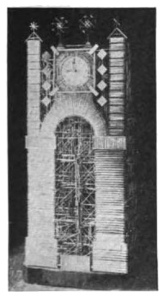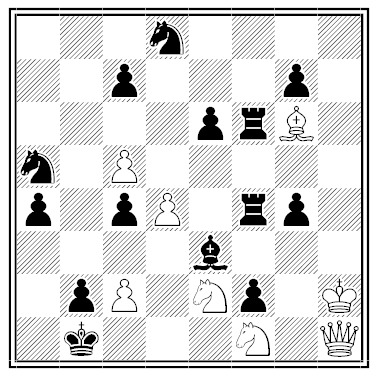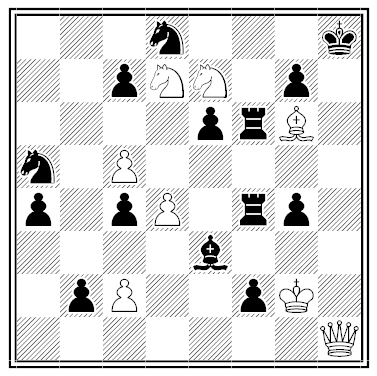A merchant who traded in cocoa
Much admired that strange style called rococo.
You’ll be happy to learn
That the name of his firm
Is to be The Rococo Cocoa Co.
— Leigh Mercer
A merchant who traded in cocoa
Much admired that strange style called rococo.
You’ll be happy to learn
That the name of his firm
Is to be The Rococo Cocoa Co.
— Leigh Mercer

Of the Second Impressionist Exhibition of 1876, critic Albert Wolff wrote in Le Figaro: “Five or six lunatics, one of them a woman — a collection of unfortunates tainted by the folly of ambition — have met here to exhibit their works. … What a terrifying spectacle is this of human vanity stretched to the verge of dementia. Someone should tell M. Pissarro forcibly that trees are never violet, that the sky is never the colour of fresh butter, that nowhere on earth are things to be seen as he paints them. …”
When J.L. Gérôme was conducting President Loubet around the exhibitions at the Exposition Universelle of 1900, he stopped him at the door of the Impressionist room, saying, “Arrêtez, Monsieur le Président, c’est ici le déshonneur de la France!”
In early April 1922, a little girl, Pauline Picard, disappeared from her parents’ farm in Brittany. Searches turned up no clues, and eventually it was thought that she had been carried off by gypsies.
Then word came from Cherbourg that a girl had been found who matched Pauline’s description. The parents hurried to claim her, but they found that the girl did not seem to know them, and she remained silent when addressed in Breton. They returned with her to their village, where the neighbors recognized her, and the attending policeman was satisfied she was Pauline Picard.
Then, in May, a farmer crossing a local field discovered the mutilated body of a young girl. She could not be identified, but her parents recognized Pauline’s clothes.
The New York Times reported: “Although it would seem almost incredible that the parents should make a mistake, the Picards are now uncertain whether the child they have been nursing for more than a month is really their own, and the police are faced by a three-fold task — to discover the murderer, identify the murdered child, and, if she is proved to be Pauline Picard, discover the identity of the little girl from Cherbourg.”
I can’t find any record that they succeeded.
“No person was ever honored for what he received. Honor has been the reward for what he gave.” — Calvin Coolidge
A logic exercise by Lewis Carroll. What conclusion is implied by these premises?

“There is probably no more unsuitable material with which to build a clock than straw. Yet this has been accomplished recently by a German shoemaker, who, during his leisure time, has made the ingenious piece of mechanism illustrated herewith. One would think that at least certain of the movable parts, or the springs, would be fashioned of some hard material such as bone, wood, or metal, yet nothing else was employed but straw. The figures, hands, dial, pendulums, chain, weight, gears, and the whole skeleton consist of this breakable stuff. By pressing a button, which comes out automatically on one side, the clockwork is wound up, and runs for five hours. There are eight pendulums, which allow regulation of speed. The chain is fourteen inches long and without end, like that of a bicycle. The diameter of the dial is eight inches. There were probably some thousands of stalks used in the work, each being three and four fold, to give more strength, one sliding within the other. No less than fifteen years was required to complete this wonderful clock.”
— Strand, July 1908

Russian champion Alexander Petrov composed this study in 1824. Galloping Cossacks chase Napoleon from Moscow (b1) across the Berezina (the long white diagonal) to Paris (h8), “where the Czar achieves his victory, by a ‘check by discovery’.”
White’s knights accomplish the task in 14 moves. All the black king’s moves are forced:
1. Nd2+ 2. Nc3+ 3. Nb1+ 4. Na2+ 5. Na3+ 6. Nb4+ 7. Nb5+ 8. Na6+ 9. Na7+ 10. Nb8+ 11. Nc8+ 12. Nd7+ 13. Ne7+ 14. Kg2#

Two old chestnuts:
1. I have six pieces of chain, each consisting of four links. It costs 10 cents to cut open one link and 25 cents to weld it together again. What will it cost to have the six pieces joined into one chain?
2. The two volumes of my scintillating autobiography stand side by side in order on a shelf. A bookworm starts at page 1 of volume 1 and eats his way in a straight line to the last page of volume 2. If each cover is 1/8 of an inch thick, and each book without the covers is 2 inches thick, how far does the bookworm travel?
And two trick questions:
1. What is the name of the title character in The Merchant of Venice?
2. Who played Frankenstein in the 1931 American film?

In short, there appears to be something paradoxical about the horror genre. It obviously attracts consumers; but it seems to do so by means of the expressly repulsive. Furthermore, the horror genre gives every evidence of being pleasurable to its audience, but it does so by means of trafficking in the very sorts of things that cause disquiet, distress, and displeasure. So different ways of clarifying the question ‘Why horror?’ are to ask: ‘Why are horror audiences attracted by what, typically (in everyday life), should (and would) repel them?,’ or ‘How can horror audiences find pleasure in what by nature is distressful and unpleasant?’
— Noël Carroll, “Why Horror?” in Alex Neill and Aaron Ridley, eds., Arguing About Art, 1995
In 1979, the California Court of Appeal reversed the conviction of a California man for possessing obscene films. Justice L. Thaxton Hanson wrote a long dissent implying that his colleagues favored pornography. In return, Justice Robert Thompson added a footnote to the majority opinion:
We feel compelled by the nature of the attack in the dissenting opinion to spell out a response:
1. Some answer is required to the dissent’s charge.
2. Certainly we do not endorse ‘victimless crime.’
3. How that question is involved escapes us.
4. Moreover, the constitutional issue is significant.
5. Ultimately it must be addressed in light of precedent.
6. Certainly the course of precedent is clear.
7. Knowing that, our result is compelled.
Read the first letter of each line.
John Peale Bishop (1892-1944) composed this acrostical poem, entitled “A Recollection”:
Famously she descended, her red hair
Unbound and bronzed by sea-reflections, caught
Crinkled with sea-pearls. The fine slender taut
Knees that let down her feet upon the air,
Young breasts, slim flanks and golden quarries were
Odder than when the young distraught
Unknown Venetian, painting her portrait, thought
He’d not imagined what he painted there.
And I too commerced with that golden cloud:
Lipped her delicious hands and had my ease
Faring fantastically, perversely proud.
All loveliness demands our courtesies.
Since she was dead I praised her as I could
Silently, among the Barberini bees.
I haven’t been able to learn anything more about it.